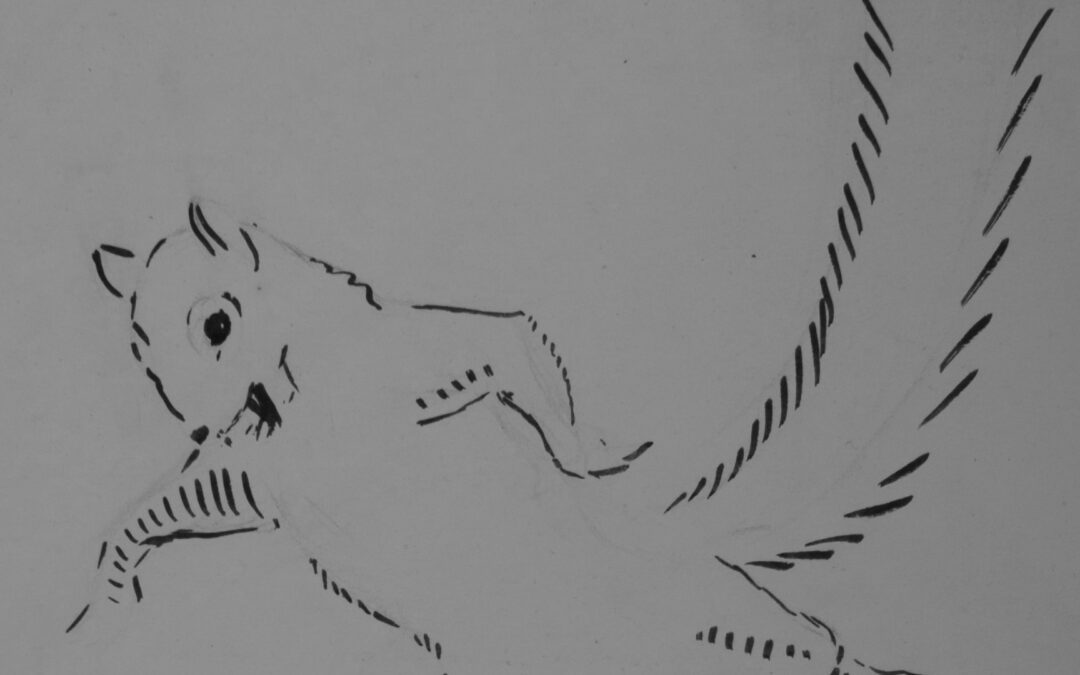Undated squirrel drawing by Seton (not associated with the article)
The great migrations of the world: The Wildebeest of Tanzania. The Caribou of Alaska. The Squirrels of New York. (!?)
Perhaps not exactly.
In between the publication of Life-Histories of Northern Animals (1909) and Lives of Game Animals (LGA, beginning 1925) Seton published additional animal natural history observations in scholarly journals. I won’t include his sources here, but in his article on the Gray Squirrel the evidence he cites is in the same style and approach as in LGA. Excerpts are from the February 1920 edition of the Journal of Mammalogy. (Species name: Sciurus carolinensis.)
“Migrations of the Graysquirrel By Ernest Thompson Seton”
One of the most interesting animal phenomena recorded by the early naturalists was the migration, or rather the emigration, of the gray-squirrel.
A true migratory animal is one that makes a periodic change of range, which has a definite going, and a definite return. Thus, the migration of birds, bats, and caribou are definite seasonal changes followed always by a return movement, but the migration of the gray-squirrel will I think be found in a different class.
In all the early natural histories this squirrel is called “migratory,” and amazing accounts are given of its armies appearing to devastate the farms of whole regions.
These migrations are now a thing of the past, so that we can but piece together the accounts of the earlier naturalists in seeking to explain such movements of the squirrel population. There are not many of these records, and those that exist are commonly deficient in not stating the direction or extent of the migration.
The Not Migration
A careful review of the evidence makes it very clear that these movements of the squirrels were not in any true sense migrations. That is, they were not seasonal or annual or periodic or balanced by a return movement of any kind. They were simply wholesale movements of a huge population from one region to another. Judging from numerous parallel cases, such a movement could arise only from one of five causes. Flood, fire, famine, pests or over-population.
There is no evidence for the first or second; as to famine, Kennicott, who has the most complete and detailed observations of all, makes a point of it that they are not driven forth by want of food, for the animals are fat at the time and the regions they leave still abound with food. Furthermore, the season when they go forth is early autumn, the time of the greatest food abundance.
It is possible that the vast multiplication of nesting places may have resulted in an insupportable increase of parasites in the shelters so that the nests had become untenable. But of this there are only two shreds of evidence at hand. One, the known fact, that overcrowded squirrel nests breed abundant parasites; second the squirrels are comparatively scarce after the army has gone. Thus, the evidence is far from conclusive.
Too Many Squirrels
We have, then, the last cause to consider—over-population. The army has always come from a-land of plenty—a place of ideal squirrel conditions—at a time when they seemed at their best, and further, the time of migration is always just as the broods of the year are full grown.
No one has ever recorded a squirrel migrating from a land when they were few or moderate in numbers, always from a place where they over-abounded. No one has witnessed one of these treks since the squirrels became comparatively scarce.
###

